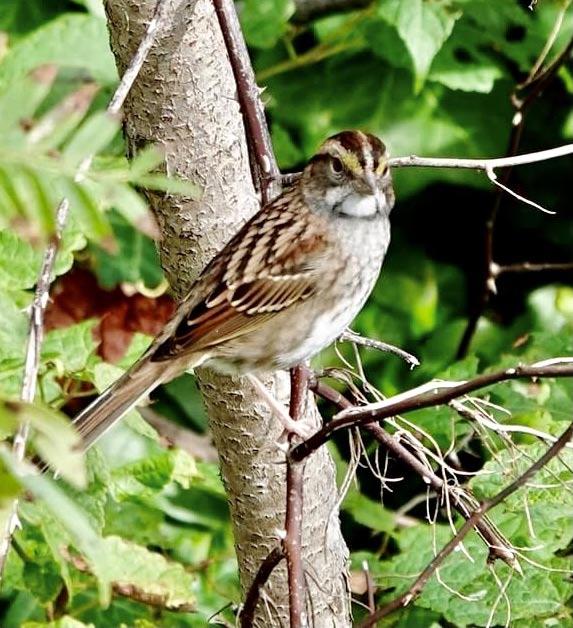
3 minute read
BIRDwatch
White-throated Sparrows
By Cecily Nabors
Seasons come and seasons go, and how do we keep track? Bird migration is one way to tell time on Mother Nature’s clock. White-throated Sparrows (Zonotrichia albicollis) breed farther north, but they’re with us in the Mid-Atlantic from midOctober to early May. The autumn return of these handsome sparrows to our yards and gardens makes the thought of impending winter more bearable. White-throats are “differential” migrants: Females go farther south than males, because they’re smaller and less able to handle cold. At our latitude, it’s likely that we see more males than females. These birds keep the same bright plumage all year. As their name implies, all White-throated Sparrows have white throats. Dark crown stripes and eyelines are common as well. But this species has two color morphs, seen in the central crown stripe and eyebrow color: tan in one morph, white in the other. What’s fascinating is that the two usually mate: a white-striped male will seek a tan-striped female; a tan-striped male will mate with a white-striped female. Studies have shown that white-striped birds are more aggressive in territorial defense, while tan-stripes are more nestoriented. The pairing of white and tan forms creates a good team for raising young. Since they don’t breed here, we don’t hear much White-throat song, but can listen for sharp chip notes and soft “seet” calls as a small flock forages. When they do sing, often on a bright winter day, their tremulous whistle, a song that Theodore Roosevelt called “singularly sweet and plaintive,” is instantly recognizable. Males of both morphs and white-striped females sing. Their familiar song, with its two slow opening notes followed by three triplets, is often represented as “Old Sam Peabody, Peabody, Peabody,” or for our northern neighbors, “O sweet Canada, Canada, Canada.” However, a shortened version of the song, with duplets rather than triplets, originated in western areas and has spread across North America in the last 20 years. Research by the Cornell Lab of Ornithology indicates the new song was learned and spread on the wintering grounds where the birds gather in flocks. The tune went viral as they dispersed for nesting. White-throats nest in the northeastern U.S. and as far north as the boreal forests of northern Canada. They build cup nests of grasses and weed stems, usually on the ground tucked under shrubs, or in the lower shrub branches. They feed their nestlings soft-bodied insects. Like most sparrows, adult Whitethroated Sparrows are mainly groundfeeders and seed-eaters, most active near dawn or dusk. Sparrows forage in gardens, forested areas, and brushy edges, scratching backward with both feet to overturn leaf litter in their search. They glean seeds of crops and weeds (ragweed sufferers, take note!), and eat fruits and berries, including dogwood berries, grapes, blackberries, and rose hips. They’ll also take any insects they happen to uncover. Here in winter, white-throats visit wellvegetated yards and come readily to feeders. They usually hop around under hanging feeders, cleaning up spilled millet and black-oil sunflower seeds. Their short, thick bills are ideal for crushing the hard seeds to get to that richness inside. If feeders are fairly near shrubs or other places that provide good cover, these (and other) sparrows will venture out, snatch spilled seed, and skitter back under cover. This laudable caution has doubtless saved many small songbirds from predators. If a gardener builds a brush pile from fallen sticks and branches, white-throats and other small birds will use that as an escape hatch. It’s amusing to watch a Sharp-shinned or Cooper’s Hawk swoop down and then step around atop the brush pile in obvious frustration, as the prey birds huddle in safety underneath. White-throats are abundant and widespread, a “species of least concern” to the International Union for Conservation of Nature. However, in recent decades, the overall count of White-throated Sparrows, as tallied by the Breeding Bird Survey, has declined. This winter, we’ll appreciate our lively migrants as they bounce around our gardens. Perhaps the birds will teach each other (and us) new songs. o
Cecily Nabors is a retired software manager who has been watching and counting birds for much of her life. She publishes the GoodNatured Observations blog at cecilynabors.com.








